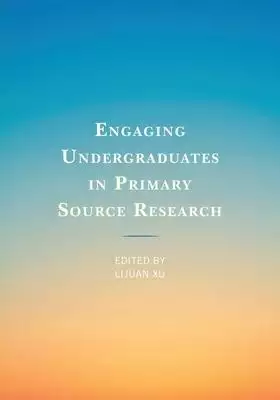Voyant Tools的問題,我們搜遍了碩博士論文和台灣出版的書籍,推薦寫的 Engaging Undergraduates in Primary Source Research 和的 Engaging Undergraduates in Primary Source Research都 可以從中找到所需的評價。
這兩本書分別來自 和所出版 。
國立臺灣科技大學 數位學習與教育研究所 黃國禎所指導 Husni Mubarok的 基於組織圖的自然語言聊天機器人策略對翻轉 EFL 學生的口語表達、運算思維傾向和文化興趣之影響 (2020),提出Voyant Tools關鍵因素是什麼,來自於图形组织者、仿制、聊天机器人、计算思维、文化兴趣、口头陈述模式。
而第二篇論文國立臺灣科技大學 電機工程系 辜志承所指導 劉俊宏的 應用機器學習於 IEC 61850 XMPP 分散式能源雲平台之太陽光伏發電預測 (2019),提出因為有 類神經網路、雲端平台、分散式再生能源、邊緣計算閘道器、IEC 61850、長短期記憶 長短期記憶、機器學習 機器學習、太陽能發電預測、XMPP的重點而找出了 Voyant Tools的解答。
Engaging Undergraduates in Primary Source Research

為了解決Voyant Tools 的問題,作者 這樣論述:
Lijuan Xu has been immersed in information literacy-related work since 1998. Her three-year stint as a user education librarian at SUNY Albany and fifteen-year tenure as the associate director of research and instruction at Lafayette College have helped her garner rich information literacy experienc
es. In addition to partnering with individual faculty members to build information literacy into their courses, Lijuan has collaborated with the Center for the Integration of Teaching, Learning, and Scholarship (CITLS) and the College Writing Program (CWP) to organize lunchtime events such as the fa
culty information literacy presentation and the "What’s Your Favorite Writing Assignment" panel. Through the grant-funded HathiTrust-based "Digging Deeper Reaching Further" initiative, she has taught text mining workshops at different institutions, including Harvard and Columbia. At Lafayette, she h
as teamed up with faculty members to explore the application of computational tools such as Voyant in primary source-based teaching.
基於組織圖的自然語言聊天機器人策略對翻轉 EFL 學生的口語表達、運算思維傾向和文化興趣之影響
為了解決Voyant Tools 的問題,作者Husni Mubarok 這樣論述:
本研究探讨了基于图形组织器的自然语言聊天机器人方法对翻转课堂中 EFL 学生的口语表现、计算思维倾向和文化兴趣的影响。本研究采用准实验设计,其中ELF(英语作为外语)两个班的48名学生。实验组(n=27)被分配到基于图形组织的自然语言聊天机器人方法(GO-NLC),而对照组(n=21)被分配到传统的自然语言聊天机器人方法(C-NLC)翻转课堂。数据通过混合设计方差分析、顺序分析和 Voyant 工具进行分析。本研究结果表明,实验组不仅显着提高了学生的口头表达能力,而且还提高了学生的计算思维倾向。然而,文化兴趣在实验组和对照组之间没有显着差异。此外,GO-NLC 策略提高了学生组织信息与机器人
对话的技能,比 C-NLC 策略更自信、更具互动性和创造性。
Engaging Undergraduates in Primary Source Research

為了解決Voyant Tools 的問題,作者 這樣論述:
Lijuan Xu has been immersed in information literacy-related work since 1998. Her three-year stint as a user education librarian at SUNY Albany and fifteen-year tenure as the associate director of research and instruction at Lafayette College have helped her garner rich information literacy experienc
es. In addition to partnering with individual faculty members to build information literacy into their courses, Lijuan has collaborated with the Center for the Integration of Teaching, Learning, and Scholarship (CITLS) and the College Writing Program (CWP) to organize lunchtime events such as the fa
culty information literacy presentation and the "What’s Your Favorite Writing Assignment" panel. Through the grant-funded HathiTrust-based "Digging Deeper Reaching Further" initiative, she has taught text mining workshops at different institutions, including Harvard and Columbia. At Lafayette, she h
as teamed up with faculty members to explore the application of computational tools such as Voyant in primary source-based teaching.
應用機器學習於 IEC 61850 XMPP 分散式能源雲平台之太陽光伏發電預測
為了解決Voyant Tools 的問題,作者劉俊宏 這樣論述:
近幾年來,分散式再生能源的快速探索和開發,為各國能源政策、技術和能源市場的發展翻開了新篇章。在分散式再生能源 (DERs)大量的併入電網之際,由於其分散各處和多樣性與間歇性的發電特性在電力系統運行、穩定性、可靠性、資訊互通性及政策、技術和經濟各方面帶來了嚴苛的挑戰。此外,大量分散式再生能源的併網對傳統的集中式發電廠和調度控制中心的運行產生了重大影響。在這種情況下,分散式再生能源相關研究的創新概念正在該領域得到廣泛的討論和發展。本論文提出一種基於物聯網的IEC 61850 XMPP雲平台分散式再生能源管理系統的新穎架構,並在台灣電力公司綜合研究所進行試驗。該架構基於歐洲CEN-CENELEC-
ETSI 智慧電網協調小組(SG-CG)的智慧電網架構模型(SGAM)設計以及採用NIST IEC 62357智慧電網互通性標準及發展藍圖。此外,本論文還提出了基於工業務聯網參考架構(IIRA)的標準化 ICT技術來支援此智慧電網架構。基於IEC 61850 XMPP雲平台架構上,本文研究並建置一套機器學習方法論,通過使用長短期記憶類神經網路(LSTM)多步時間序列預測理論來預測24小時之太陽能發電。通過資料處理、模型擬合、交叉驗證、指標評估和超參數調優的機器學習過程,實驗結果顯示平均RMSE為0.512,這數據驗證本文所提出的架構與方法適合用於短期太陽能發電預測。本論文提出的研究架構與方法,
可以提供給未來相關領域研究者更深入的進行發電預測相關探討,並運用於各種輔助服務模式的開發,進而強化電力系統供電品質與可靠度。